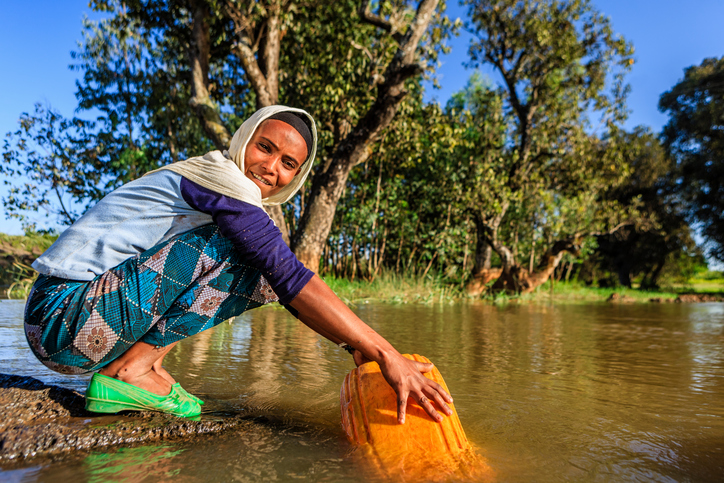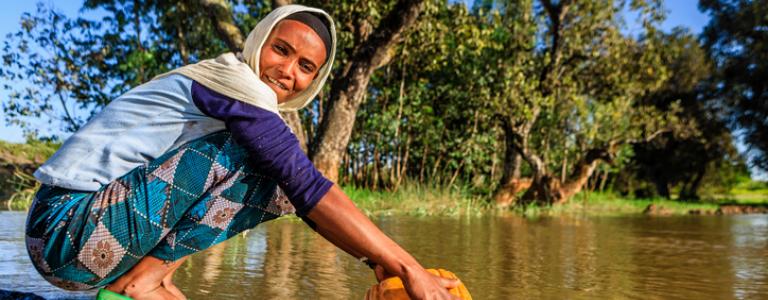Ensuring Access to Water and Sanitation for All: What SDG 6 wants to achieve and why it matters
This World Water Day, we take a look at Sustainable Development Goal 6 ("ensure access to water and sanitation for all") and explain what it is meant to acheive, and why it matters.
Many of us take water—the world’s most essential element—for granted.
Sadly, a quick look at how Cape Town is coping with an ever-intensifying water crisis is a stark reminder of how critical this resource is to our daily lives.
Water scarcity affects more than 40 per cent of the world, and that number continues to rise. In fact, a recent report from the UN warns that water shortages could affect 5 billion people by 2050.
Today, almost 2 billion people drink water contaminated by faeces, and even more people lack access to basic sanitation facilities such as toilets or latrines.
Oceans and lakes across the planet are plagued by challenges such as algal blooms, invasive species and pollutants like mercury, selenium and microplastics.
With forces such as climate change, population growth, pollution and competition for resources intensifying, the need to develop solutions to ensure clean and accessible water has never been more urgent.
Water and Sanitation for All
The Sustainable Development Goals (SDGs) aim to address these issues, not only with a focus on water and sanitation in SDG 6 but through related targets in many other goals. SDG 6 encompasses targets that seek to address everything from water quality issues, pollution and the efficiency of water usage to how water is managed, and the role of all players from international governments to local communities.

The Millennium Development Goals—the precursor to the SDGs—addressed water and sanitation as a subset of the goal to “ensure environmental sustainability.” The critical importance of clean and accessible water for health, productivity and the environment is demonstrated by the fact that has an SDG goal dedicated solely to its promotion.
The SDGs are also a universal agenda, applying to all countries regardless of income or development status. This means that it is critical for countries like Canada—the country with the greatest access to fresh water in the world—and the United States to consider how they manage and govern their water resources.
Water scarcity affects more than 40 per cent of the world, and that number continues to rise. In fact, a recent report from the UN warns that water shortages could affect 5 billion people by 2050.
Furthermore, SDG 6 calls for both developing and developed countries to consider access to water for their citizens. Notably, Canada, with its vast reserves of fresh water, still maintains boil-water advisories for some 100 Indigenous communities.
For example, Target 6.B calls for countries to “support and strengthen the participation of local communities in improving water and sanitation management.” Projects like empowering citizen science and working with Indigenous communities in northern Canada, give communities and individuals an opportunity to understand and protect their water supplies.
Similarly, Target 6.5 aims to “implement integrated water resources management at all levels, including through transboundary cooperation as appropriate.” An example of this is IISD’s work in the Lake Winnipeg basin, which spans provincial, state and international boundaries. We are working to integrate the process of watershed management, while addressing environmental and socioeconomic concerns in the basin through innovative landscape management, policies and programs—throughout the Canadian prairies and northern US states.
Positive progress
Achieving the SDGs' water-related goals and targets is within reach. Recent statistics from the United Nations show that over 90 per cent of people worldwide use improved drinking water sources. However, these sources were not always managed safely, and sub-Saharan Africa and Oceania still bear the brunt of that inequality.
Plans for the integrated management of water resources are under way in countries in every region (65 per cent of 130 countries in 2012). Even so, implementation varies across regions, with western Asia, Latin America and the Caribbean, and sub-Saharan Africa still at the earlier stages.
The High-level Political Forum on Sustainable Development is the United Nations’ main platform on sustainable development, and regularly assesses and reports on the progress of the Sustainable Development Goals. It also encourages member states to do the same—known as “voluntary national reviews.” It next meets in July, where it will report on the status of several SDGs, including SDG 6.
Find more news and information on SDG6 at the SDG Knowledge Hub. Or learn more about IISD’s work to advance water policy and programming solutions.
You might also be interested in
IISD Annual Report 2022–2023
At IISD, we’ve been working for more than three decades to create a world where people and the planet thrive. As the climate crisis unfolds on our doorsteps and irreversible tipping points loom, our team has been focused more than ever on impact.
How can we improve on freshwater health and prevent plastic pollution?
INC-4 is the fourth meeting in a series of international negotiations that aims to develop a global treaty on plastic pollution that could and should have big implications for freshwater quality both in Canada and beyond.
Progressing National SDGs Implementation
An independent assessment of the voluntary national review reports submitted to the United Nations High-level Political Forum on Sustainable Development in 2023.
Microplastics found in remote waters near Great Lakes in 'alarming' new study
By land, by sea, and now by air - microplastics are contaminating the world's most remote locations without the help of people. The fibers and fragments that shed from clothes and fall off car tires have been found in commercial seafood, drinking water, and in humans. As concerning as the findings are, a new study suggests another troubling conclusion: microscopic plastic particles are reaching corners of the world untouched by people.
